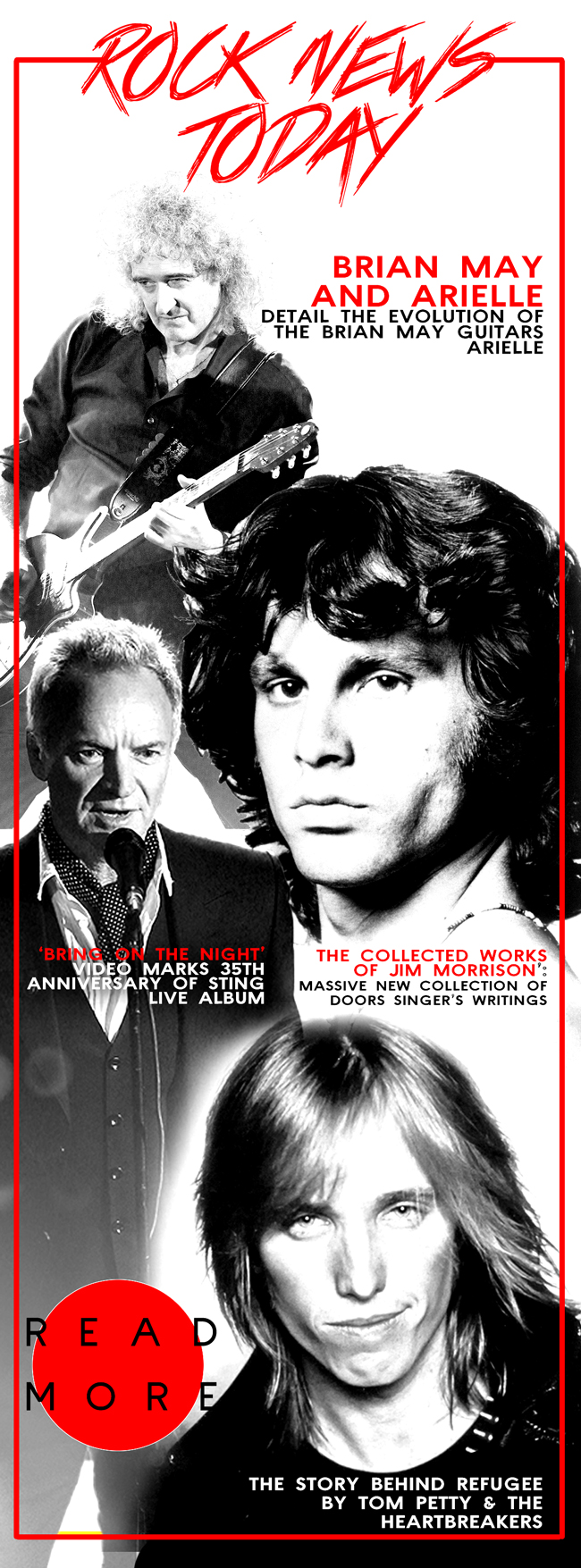



‘The Collected Works of Jim Morrison’: Massive New Collection of Doors Singer’s Writings

‘The Collected Works of Jim Morrison’ will feature unrecorded lyrics, excerpts from handwritten notebooks, a film treatment, and more from the late Doors frontman. At some point before his death in July 1971, Jim Morrison handwrote a list, titled “Plan for Book,” that laid out his thoughts on a collection of his poetry, lyrics, and other work.
Now, 50 years after his passing and the release of his last album with the Doors, that blueprint is coming to fruition in what promises to be the most exhaustive collection of his writing to date. Published June 8th by HarperCollins, The Collected Works of Jim Morrison: Poetry, Journals, Transcripts and Lyrics promises to be something of a Morrison motherlode. At nearly 600 pages long, the book — compiled with the cooperation of his estate — pulls together most of his previously published work, from song lyrics to poetry (“Horse Latitudes,” “The Celebration of the Lizard”), as well as the entirety of the posthumously published writing collections Wilderness and The American Night.
But roughly half the book consists of previously unpublished material, including unrecorded lyrics, handwritten excerpts from 28 recently discovered notebooks, and 160 photos and drawings (including rarely seen family photos). Among the excerpts from Morrison’s notebooks will be his thoughts on his trial in Miami in 1970 (he was found guilty of indecent exposure and open profanity), as well as what are believed to be Morrison’s final writings — the contents of a Paris notebook from shortly before his death, “reproduced in full reading size,” according to the publisher.
Other rarities include Morrison’s treatment for The Hitchhiker, a movie project in which he played a murderous drifter; parts of it were eventually filmed as his experimental movie HWY. An accompanying audiobook includes the first-ever release of Morrison’s final poetry recording session, held in an L.A. studio on his 27th birthday in December 1970; it is accompanied by a transcript of that tape. Author and longtime Door’s fan Tom Robbins, who reviewed a Doors show in 1967 for Helix magazine, has written a foreword, and Morrison’s sister, Anne Morrison Chewning, contributed a prologue.
Plans to commemorate the 50th anniversary of the Doors’ L.A. Woman album is also in the works. Collected Works has the potential to kickstart another Morrison revival, but it may also serve as the culmination of Morrison’s own dreams to be taken seriously as a writer. In a 1969 interview with Rolling Stone, he was asked, “Do you see yourself going more toward print?” Morrison replied, “That’s my greatest hope. That’s always been my dream.”
CREDITS: - David Browne
Brian May and Arielle detail the evolution of the Brian May Guitars Arielle

Brian May and Arielle detail the evolution of the Brian May Guitars Arielle
The Queen guitarist welcomes a new addition to his BMG range, designed by rising guitar force Arielle. The sound of Brian May’s Red Special guitar is one of the most singular in rock. With its unique switching system wringing every drop of tone out of his trio of Burns Tri-Sonic pickups, it’s been Brian’s faithful companion on a hoard of hit records.
American musician Arielle set out to replicate the Red Special’s tonal palette on her own self-designed instrument, ‘Two-Tone’, and it wasn’t long before discussions began regarding adding it to the stable of Brian’s guitars, albeit in a slightly modified form. The result is a beguiling blend of influences – a little bit Firebird here, with maybe a touch of Explorer there, but at its heart it has the fire and fury of a thoroughbred with a nod to the guitar that Brian designed with his dad in the garden shed many moons ago. We caught up with both Brian and Arielle to get the lowdown on the new BMG Arielle Guitar.
How did you first connect with Arielle?
“I’ve known Arielle for a long, long time. Way before anyone had seen her, as such. We’ve kept in touch over the years and so I did know that she had designed her own guitar, but I hadn’t seen it until we bumped into each other on one of our tours. She gave it to me to play and so that was really the turning point. I picked it up and it felt like home, really; I immediately felt that I could do what I need to do on it.
“There are certain things on my guitar that have become almost part of me, like the switching on the pickups and the feel of the neck and a few other things that are very ‘me’. I didn’t expect that to happen because the guitar looks so different from anything that I’ve enjoyed, so when I picked it up and it felt so absolutely friendly to me and made the right kind of noises – very much the right kind of noises – I just thought how interesting it would be to collaborate.”
How did the process begin?
“We set the guidelines down immediately, I think, because Arielle said she would like to have the pickups from my guitar and the switching system, which is something that me and my dad originated. It gives you a very wide range of tones. Arielle and I are probably the only two people in the world who can instantly recognize which of those settings the guitar is on. “I sent her a tape last night or the night before and said, ‘Have a listen to this,’ and she went, ‘Ah yes, that was the bridge pickup and the fingerboard pickup out of phase,’ and I went, ‘Yep.’ So, we combined some of the features of my guitar and Arielle’s.
“The headstock is very much my thing. I couldn’t understand why guitar headstocks have machine heads all up one side and you had to put clamps in to make the strings sit in the nut, you know? Why do people do that? Because you can just make the strings come straight through, you lessen the friction and each one comes through its particular point that is already lined up on the headstock.
“We agreed we would do that – the symmetrical headstock – but it’s quite nice because it has the asymmetrical flash on it, paint-wise, so it very much harmonizes with the feel of Arielle’s guitar body.”
Did the design for the BMG version of Arielle’s guitar evolve over time?
“It took a little bit of evolution, a bit of time. The big thing that is different about Arielle is that she’s much more sensitive to woods than I was. I just kind of made [mine] out of junk. I had a 100-year-old fireplace and that was the piece of wood that was hanging around in my dad’s workshop and so that was going to be the neck. I had some blockboard, I had some veneer, I had some oak to make the body out of, so that’s what happened.
“It would be nice for Brian May Guitars to make something that was angled towards a woman because women guitar players are becoming so much more of a force in rock music, and I love that” – Brian May.
“Now, I don’t know whether it was good luck or good guidance or whatever, but it worked for my guitar. But Arielle has tried a lot of different woods and she was very particular about how the woods would be combined to make this guitar, and we actually tried a few things during the production prototypes. To be honest, I’d never paid that much attention to it, but now I get it. Now I understand why she was so particular because this guitar really does have a sort of springy lightness to it. “And what I’ve missed out, I suppose, is that Arielle said that no guitar has ever been designed with a woman in mind – hasn’t been designed with that sort of sensitivity toward a woman’s body shape.
“So, this guitar appealed to me on that basis, that it would be nice for Brian May Guitars to make something that was angled towards a woman because women guitar players are becoming so much more of a force in rock music, and I love that. That’s the way it always should have been.”
What gear do you use live?
“I kind of take the Eric Johnson approach of having an amp for each separate tone that I want and so I used my Blankenship Fat Boy for my lead, I used a Two-Rock for my clean and then my Divided By 13 RSA 31 for my dirty rhythm. They’re never on at the same time and I have them set up for different effects. In my lead chain I just have an overdrive pedal, which is a J Rockett Animal – they’ve changed them now, but I use an old one – and I use a TC Flashback for the delay.
“Then, for my clean chain, I use a vintage '80s chorus pedal and I use a Catalinbread Echorec. Then I have a compressor as well. For the overdriven tone I just kind of break it up with the amp and then I switch between them depending on where I am in the song, which helps me because I’m singing most of the time, so I don’t really have time to stomp around on pedals or anything.”
Credits: By David Mead (Guitarist) – Guitarworld.com
‘Bring On The Night’ Video Marks 35th Anniversary Of Sting Live Album

The clip, like the album, captures the excitement of live performances by Sting and his stellar band in Europe in 1985.
The 35th anniversary of Sting’s live album Bring On The Night, first released on July 1, 1986, has been marked by a video release on YouTube of the title track. The clip combines animation and live footage to capture, as does the album, the excitement of live performances by Sting and his stellar band in Europe in 1985. The video was previously part of a home video release but has not been available digitally until now.
The Bring On The Night album followed the theatrical release in October 1985 of a feature documentary of the same name. Both projects were based on the busy period of live performances that followed the superstar’s hugely successful first
solo album The Dream Of The Blue Turtles.
In early 1985, Sting recruited the band of A-list musicians who would play on that studio set, comprising Kenny Kirkland (keyboards), Darryl Jones (bass), Branford Marsalis (saxophone), Omar Hakim (drums), with backing vocalists Janice Pendarvis and Dollette McDonald.
In May that year, he relocated to Paris, where he and the band played a series of shows at the Mogador Theater.
He was accompanied by a film crew, led by director Michael Apted, who filmed the band extensively over a nine-day period during rehearsals, at the Chateau de Courson, for the week of shows. Apted and his team interviewed all of the band members and documented the creation of the stage set and lighting, press conferences and photo shoots conducted at the time, and then filmed the concerts extensively.
The album incarnation of Bring On The Night featured performances from the Paris shows but also from those seven months later, in December, in Rome, Arnhem, and on a return trip to Paris, by which time the band had played some 80 shows together. The album begins with a segue of The Police’s “Bring On The Night/When The World Is Running Down” but proceeds to focus chiefly on Sting’s new and recent solo material, rather than rely on staple Police hits.
Lesser-known songs by that multi-platinum trio such as the B-side “Low Life” and a closing “Tea In The Sahara,” but elsewhere there are solo gems from The Dream Of The Blue Turtles like “We Work The Black Seam,” “Consider Me Gone,” and “Moon Over Bourbon Street.”
Bring On The Night went on to reach No.16 in the UK and the whole album won a Grammy Award in 1988 for Best Pop Vocal Performance, Male, beating such other nominees as Michael Jackson’s Bad.
As the album liner notes conclude: “This was an awesome live band as anyone who saw them will tell you, and this release does the band’s memory justice. The especially pleasing thing about the album is the lack of obvious crowd-pleasing Police favorites ‘Roxanne,’ ‘Every Little Thing She Does Is Magic,’ ‘Message In A Bottle’ etc.
With Sting instead relying on a mixture of his new material, Police medleys that show off the band’s virtuosity, and on long overlooked songs such as ‘Low Life’ and ‘I Burn For You.’ Great music played with style and skill – you can’t go wrong with Bring On The Night.”
CREDITS: Paul Sexton / udiscovermusic.com
The story behind Refugee by Tom Petty & The Heartbreakers

Tom Petty & The Heartbreakers' Refugee was a true band collaboration and took a hundred takes to get right.
Sandwiched between punk, the first moans of goth and the flagging first wave of New Wave, Tom Petty And The Heartbreakers’ track Refugee took a defiant step in reasserting the dominance of guitar rock at the butt end of the 70s.
Not only did this prickly anthem propel the band into the US Billboard chart and help make them a household name, with the anxious minor key menace of Mike Campbell’s opening guitar shot it also helped banish the lingering malaise of a world afflicted with disco fever.
It was a dark, dangerous sound that came to the guitarist late one afternoon while he sat listening to John Mayall’s version of Oh Pretty Woman which featured a very young pre-Rolling Stones Mick Taylor on guitar. It was Taylor’s playing that was the real inspiration for Refugee.
“I love that album [Crusade, 1967],” Campbell says. “I’d just put it on and practice guitar along with it. I love the way Mick Taylor plays, and maybe some of it rubbed off.
By Jaan Uhelszki (Classic Rock)








